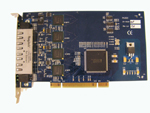AEI-P430C
|
 |
The AEI-P430C Quad Fast Ethernet (QFE) card is based on the popular
Intel 82559 Ethernet Controller chipset. The device driver is
embedded into many operating systems, and hence plug and play in
Windows, Linux, and other operating systems.
Firewalls and application servers on Fast Ethernet networks can now
get the bandwidth they need with the P430C Quadport PCI network
interface card. This high-performance card can support four separate
10/100 Mbps copper network segments at full bandwidth.
Unlike many "server class" adapters on the market today, the P430C was designed for cross platform. This means additional noise impedance has been engineered into the board. The P430C has a clean design, high precision oscillator, integrated magnetics, high-end surface mount discrete components, and additional filtering. The cumulative effect is a card that is high performance, highly reliable, and fault tolerant. Subsequently, it provides a much higher return on investment when compared to the competition.
The P430C is provided with universal keying to support either 3.3V or 5V systems.
The P430C is fully interoperable with existing Ethernet hubs, switches and routers. AEI Fast Ethernet cards provided increased bandwidth for event the most congested network.
Features
-
Checkpoint Certified.
-
Consolidate multiple server ports onto a single card
-
Cross Platform Support for all popular server platforms.
-
Reduces Server Overhead.
-
Easy to install and configure.
-
Half or Full Duplex operation.
-
Dual speed 10Mbps (10Base-T) or 100 Mbps (100Base-Tx)
-
Maximum throughput of 800Mbps.
-
DMA Bus Mastering for lower CPU utilization.
-
Universal Short Card form factor.
Applications
-
Firewalls and other Internet security appliances.
-
Proxy, application, file, and print servers.
-
SOHO to Enterprise network environments.
-
Internet Service Providers / Web Hosting
-
Storage Area Networks (SAN)
-
Network Attached Storage (NAS)
-
Network segmentation (for network security purposes)
-
Gateways and routers.
Specifications
| Configurations |
AEI-P430C.. PCI 10/100 Quad Fast Ethernet NIC. |
| Connector | Quad
RJ-45(f) 10/100Base-Tx with integrated magnetics module. |
| IEEE Standards | IEEE
802.3 (10Base-T Ethernet) IEEE 802.3u (100Base-Tx Ethernet) IEEE 802.3ad (Port Aggregation) 802.1Q (VLAN) 802.1x (Flow Control) Fast EtherChannel (FEC) supported. |
| Speeds |
10Base-T (Up to 20Mbps) 100Base-Tx ( Up to 200 Mbps) |
| Interrupt Coalescing | All four ports share one IRQ |
| Duplex | Half or Full Duplex operation |
| Boot ROM | Contact Us for details |
| Parallel Detection | Yes |
|
Auto-negotiation / NWay |
Auto-negotiation between full and
half duplex operations, AND |
| Data transfer Mode | DMA Bus Mastering |
| LEDs | Link, Activity, and Speed |
| Slot Type |
32/64-bit, 33MHz 3.3V or 5V slot Universal short card |
| Bus Type | PCI 2.1 & 2.2 compliant, compatible with PCI-X slots |
| Driver Support |
Device Drivers
Drivers are built into the operating system (plug & play) in virtually all Windows 32-bit OS, Linux, and other popular operating systems.
MS-DOS For Windows Vista and Server 2008 (Click
Here) |
| Certifications | FCC
Part 15, Subpart B - Class A; CE EN 55024:1998+A1:2001+A2:2003 Part 1 of BS EN 60950 BS EN 61000-3-2:2001 EN 61000-3-3:2008 |
| MTBF * | 120 Years |
| Environment Specs |
Temperature: operating 0C to 60C Humidity: 10 to 95% non-condensing |
| Dimensions | 6.8"
(L) x 4.2" (H) Universal Short Card |
| Power Consumption |
Operating Voltage: 3.3VDC/5VDC Consumption: 1.6W |
* According to Telcordia SR-332 Issue 1 Environmental condition – GB (Ground, Fixed, Controlled). Ambient temperature - 25°C. Temperature rise of 10°C above the system ambient temperature was assumed for the cards components.
.jpg)
